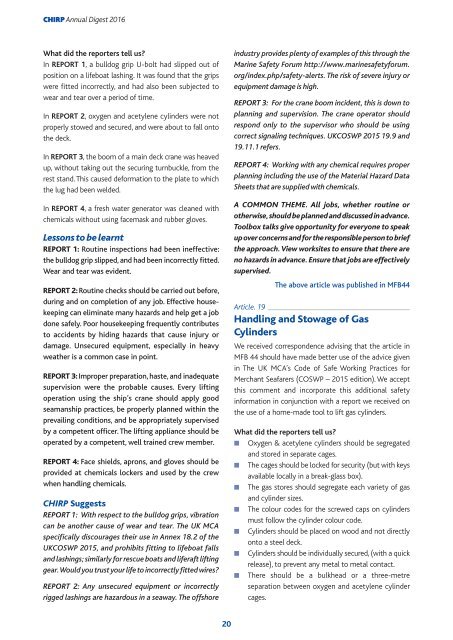CHIRP annual digest 2016 6th
Create successful ePaper yourself
Turn your PDF publications into a flip-book with our unique Google optimized e-Paper software.
<strong>CHIRP</strong> Annual Digest <strong>2016</strong><br />
What did the reporters tell us?<br />
In REPORT 1, a bulldog grip U-bolt had slipped out of<br />
position on a lifeboat lashing. It was found that the grips<br />
were fitted incorrectly, and had also been subjected to<br />
wear and tear over a period of time.<br />
In REPORT 2, oxygen and acetylene cylinders were not<br />
properly stowed and secured, and were about to fall onto<br />
the deck.<br />
In REPORT 3, the boom of a main deck crane was heaved<br />
up, without taking out the securing turnbuckle, from the<br />
rest stand. This caused deformation to the plate to which<br />
the lug had been welded.<br />
In REPORT 4, a fresh water generator was cleaned with<br />
chemicals without using facemask and rubber gloves.<br />
Lessons to be learnt<br />
REPORT 1: Routine inspections had been ineffective:<br />
the bulldog grip slipped, and had been incorrectly fitted.<br />
Wear and tear was evident.<br />
REPORT 2: Routine checks should be carried out before,<br />
during and on completion of any job. Effective house -<br />
keeping can eliminate many hazards and help get a job<br />
done safely. Poor housekeeping frequently contributes<br />
to accidents by hiding hazards that cause injury or<br />
damage. Unsecured equipment, especially in heavy<br />
weather is a common case in point.<br />
REPORT 3: Improper preparation, haste, and inadequate<br />
supervision were the probable causes. Every lifting<br />
operation using the ship’s crane should apply good<br />
seamanship practices, be properly planned within the<br />
prevailing conditions, and be appropriately supervised<br />
by a competent officer. The lifting appliance should be<br />
operated by a competent, well trained crew member.<br />
REPORT 4: Face shields, aprons, and gloves should be<br />
provided at chemicals lockers and used by the crew<br />
when handling chemicals.<br />
<strong>CHIRP</strong> Suggests<br />
REPORT 1: With respect to the bulldog grips, vibration<br />
can be another cause of wear and tear. The UK MCA<br />
specifically discourages their use in Annex 18.2 of the<br />
UKCOSWP 2015, and prohibits fitting to lifeboat falls<br />
and lashings; similarly for rescue boats and liferaft lifting<br />
gear. Would you trust your life to incorrectly fitted wires?<br />
REPORT 2: Any unsecured equipment or incorrectly<br />
rigged lashings are hazardous in a seaway. The offshore<br />
industry provides plenty of examples of this through the<br />
Marine Safety Forum http://www.marinesafetyforum.<br />
org/index.php/safety-alerts. The risk of severe injury or<br />
equipment damage is high.<br />
REPORT 3: For the crane boom incident, this is down to<br />
planning and supervision. The crane operator should<br />
respond only to the supervisor who should be using<br />
correct signaling techniques. UKCOSWP 2015 19.9 and<br />
19.11.1 refers.<br />
REPORT 4: Working with any chemical requires proper<br />
planning including the use of the Material Hazard Data<br />
Sheets that are supplied with chemicals.<br />
A COMMON THEME. All jobs, whether routine or<br />
otherwise, should be planned and discussed in advance.<br />
Toolbox talks give opportunity for everyone to speak<br />
up over concerns and for the responsible person to brief<br />
the approach. View worksites to ensure that there are<br />
no hazards in advance. Ensure that jobs are effectively<br />
supervised.<br />
The above article was published in MFB44<br />
Article. 19<br />
Handling and Stowage of Gas<br />
Cylinders<br />
We received correspondence advising that the article in<br />
MFB 44 should have made better use of the advice given<br />
in The UK MCA’s Code of Safe Working Practices for<br />
Merchant Seafarers (COSWP – 2015 edition). We accept<br />
this comment and incorporate this additional safety<br />
information in conjunction with a report we received on<br />
the use of a home-made tool to lift gas cylinders.<br />
What did the reporters tell us?<br />
■ Oxygen & acetylene cylinders should be segregated<br />
and stored in separate cages.<br />
■ The cages should be locked for security (but with keys<br />
available locally in a break-glass box).<br />
■ The gas stores should segregate each variety of gas<br />
and cylinder sizes.<br />
■ The colour codes for the screwed caps on cylinders<br />
must follow the cylinder colour code.<br />
■ Cylinders should be placed on wood and not directly<br />
onto a steel deck.<br />
■ Cylinders should be individually secured, (with a quick<br />
release), to prevent any metal to metal contact.<br />
■ There should be a bulkhead or a three-metre<br />
separation between oxygen and acetylene cylinder<br />
cages.<br />
20



